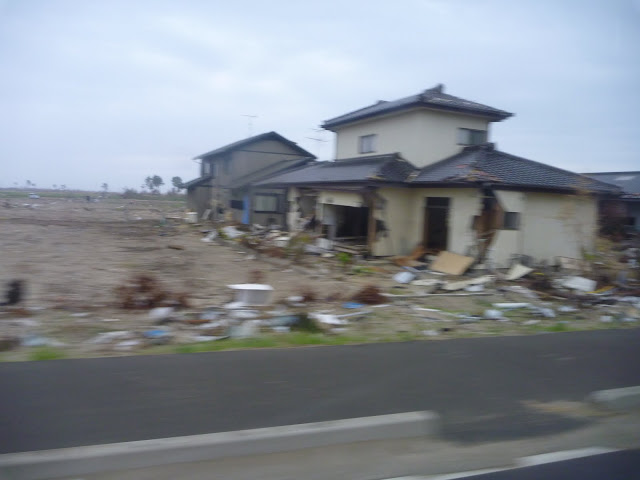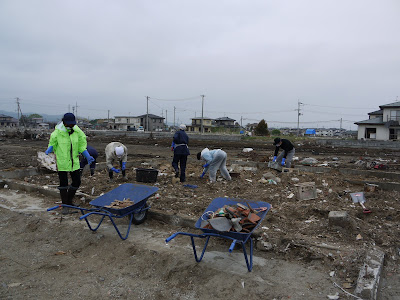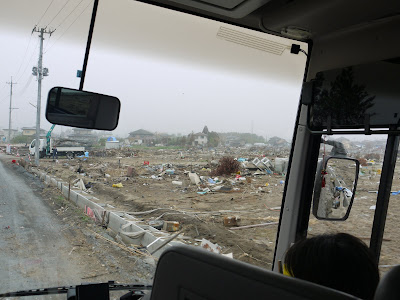 |
| That pile of junk in the foreground represents the fruits of our labor -- cleared from a wide area and ready to be hauled away. |
At least the weather forecast (now proving accurate, for once) meant that I would not miss much of a cycling opportunity by joining one of my office's volunteer trips to Tohoku.
 |
| Watari-cho: North of Soma, South of Iwanuma, Route 6 runs through it |
Watari-cho is on the wide, flat plain to the East and South of Sendai. Here the tsunami did not have the drama of some hilly valleys to the North where it built up to 30+ meters as it entered a bay like water into a funnel and destroyed everything in its path. Rather, the waves spilled out over the vast plain, coming inland much farther than anyone would have thought possible, over 2 kilometers here, and destroyed mostly houses, cars, smaller buildings, and green houses, leaving massive garbage piles in its wake.
We arrived very early in Miyagi. The center that manages volunteers does not open until 8AM, so after a break at a (fully stocked and functioning) Seven Eleven convenience store our bus driver swung around and drove through some of the nearby tsunami-damaged area, though we stayed about one kilometer inland. I felt a bit like a "disaster area tourist".
 |
| A vast plain, mostly farmland, strewn with lots and lots of junk. |
 |
| Houses survive -- no damage on the second floor, but the ground floor must be completely rebuilt. |
 |
| A real mix -- some houses look like new again, but many are not yet restored or even cleared. |
After the bus tour, it was still well before 7AM when we got to the center. At least in Tohoku Saturday morning was still dry and cool, but not cold, so I could use my Brevet survival skills, get out of the bus and lie down on a flat hard surface near the entrance to a building with my rucksack as a pillow and sleep for awhile. This was much more comfortable than sleeping in a bus full of people.
 |
| Once you get beyond the tsunami damage -- everything looks normal -- except for the energy conservation efforts |
Next door was a large building where food and other supplies were being stored for people who had lost their houses -- stacked up almost like a Costco. And across the street, almost unnoticed behind a high chain link fence, was a large parking lot where row upon row of beige temporary housing (ka-setsu jutaku) had been built. This temporary housing was right in the middle of town, right across from the supplies and close to friends and neighbors for anyone from the area -- and so does not obviously suffer from the problems that have been reported in the media -- temporary housing build in inconvenient locations, far away from the refuge centers where elderly get support from their longtime friends and neighbors, support that disappears if they win the "lottery" and move to temporary housing.
While there was, inevitably, some waiting around for the volunteer center to open, and more waiting at the end of the day for someone to come pick up the tools at our work site, there was no extra speechifying, no briefing or other nonsense. We quickly loaded our tools into a minivan and our bus followed the minivan and driver to our work locations, half our group to work at one house, the rest of us going to a second. We worked on site from 9AM until around 3:30, with a break for lunch.
My group was assigned to work at a farm house where the "new" house was still standing while the "old" house had been totaled/destroyed by the tsunami. The other group finished their job quickly and walked over to join us for lunch and the afternoon session.
We were to clean up the ground around the foundation of the "old" house and the adjacent fields. There was all kinds of junk, on the surface and buried 15-30 centimeters or more. We cleared broken roof ceramic tiles (kawara), cement blocks, lots and lots of glass of all sizes, random pieces of metal, plastic, lots of wood, deteriorating clothing, and all kinds of other stuff -- I found one cellphone, a few intact water glasses, some pots and pans, even some greeting cards. The master farmer (age 60) said that they had been at home during the earthquake and saw the tsunami warning on TV. He had thought "we should be okay this far inland", but his elderly mom insisted, 「逃げろ」 ("let's flee") so they hopped in the car and drove to visit friends on higher ground. (Their other 4 vehicles were lost to the waters, along with the "old" house). They said that just about every nearby house older than 15 years had been carried away, and the only the newer ones remained -- each of which had flood damage up to a level at least 2 or 2.5 meters above the ground.
 |
| Before |
Then it was back to the volunteer center, a quick stop at a day-trip hot spring to clean up and soak the muscles a bit, before getting back on the Tohoku Expressway, another quick stop for dinner, and back to Tokyo around 11PM.
 |
| After - the junk is gone |
 |
| More after - we pack up to head out. |
 |
| Still more work to be done ... |

















2 comments:
Great you went, very inspiring!
How do you think would cycling through the area be perceived? Showing solidarity, nuisance, annoyed people do sports for their own benefit rather than helping?
Manfred:
I think there are large parts of Tohoku -- everywhere except for the coastline and the Fukushima exclusion zone -- where they would probably welcome cyclists. You could call ahead and see if the hotels/inns are open, have room and are in need of tourist dollars. I heard that at one point hotels were all booked w/ refugees and volunteers, but that may have changed and I would not rule it out at least in Miyagi, and certainly not in tourist destinations in the mountains -- which could probably really use the business.
They also might be delighted to have volunteers who arrive by bicycle (though I cannot say for certain, as I did not plan our trip -- several of our staff, including my assistant, did the work and made the arrangements, and it followed a trip they had made during Golden Week).
As for the coast itself, I think you could probably cycle in and out of an area like Watari-cho without bothering people, though you would not be able to get much support right there and you would find some roads blocked and/or warnings about debris being cleared ahead. You might want to hitch a trailer on the back of your bicycle and bring some needed food to drop off, or organize it to fit with a McKinsey volunteer effort, or something like that?
Post a Comment